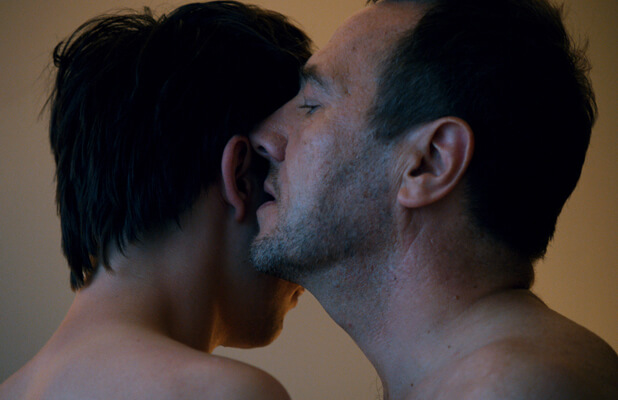Danish director Nils Malmros’ 1992 “Pain of Love.” | FILM SOCIETY OF LINCOLN CENTER
January and February are usually deserts for cinephiles, although this is less true in a city with a still-thriving film repertory scene like New York. Granted, 2015 has already brought us worthwhile films like Bruno Dumont’s “Li’l Quinquin,” Desiree Akhvan’s “Appropriate Behavor,” Peter Strickland’s “The Duke of Burgundy,” Aleksei German’s “Hard to Be a God,” and Abderrahmane Sissako’s “Timbuktu,” but most of these were fairly marginal releases that disappeared in a week or two.
In the mainstream, Michael Mann’s clumsily scripted but visually vibrant “Blackhat” was the only sign of life. That’s why winter programs like the Museum of the Moving Image’s “First Look,” MoMA’s “Documentary Fortnight,” and the Film Society of Lincoln Center’s “Film Comment Selects” are essential links for New Yorkers to the greater world of international film festivals. Programmed by the editors of Film Comment magazine, this year’s “Film Comment Selects” kicks off with a documentary on ‘80s schlock distributors Cannon Films and includes new and old films from the US, Chile, Germany, France, Italy, Hong Kong, Iran, and Japan. There are a number of titles celebrating their 40th anniversary, including Philippe Garrel’s extremely rare “Un ange passe.” The festival swerves from the austerity of Garrel to Larry Clark’s latest investigation of teenage sexuality to a collection of student films by ‘70s horror filmmakers. Here’s my take on four films I was able to sample:
Franco Maresco’s “Belluscone: A Sicilian Story” purports to be an unfinished film by the generally sarcastic and provocative Maresco, who disappeared under mysterious circumstances. It was supposedly assembled by other editors and is narrated by real-life film critic Tatti Sanguineti. The pretext, of course, is nonsense.
With impressive breadth, Film Comment Selects keeps New York in global swing
Using a fragmented structure, it tells a coherent story of the Mafia’s influence on Italian politics and culture, leading all the way up to the infamously corrupt former Prime Minister Silvio Berlusconi. But Maresco sets his sights fairly small, concentrating at first on music promoter Ciccio Mira (whose interviews are shot in black and white, while the rest of the film is in color, for some reason) and his stable of “neomelodic” artists. No one can define the neomelodic style, but while one artist says his message is anti-violence, it seems to involve frequently giving shout-outs to prisoners, sometimes including coded messages from the Mafia. Maresco’s resort to a fictional framing device suggests his difficulty getting a handle on a man as slippery as Berlusconi and an organization as big as the Mafia.
While the film is quite funny, it never settles for easy potshots at everyday Sicilian pop music fans, and some of its best jokes are aimed at the director himself. A coda, in which Italians reveal their ignorance of the Mafia’s involvement with Italian politics, suggests why Maresco made it.
(February 24, 8:30 p.m.)
This year’s “Film Comment Selects” offers a six-film retro of Danish director Nils Malmros, whose 1992 “Pain of Love” I was able to preview. Malmros is willing to delve into very challenging and difficult emotional territory, going at least as far as Ingmar Bergman. “Pain of Love” tells the story of a troubled woman named Kirsten, from childhood through young adulthood. The film is loosely based on the experiences of Malmros’ wife; his most recent film, “Sorrow and Joy,” tells the story of her infanticide of their child.
Unlike Lars von Trier’s melodramas about sacrifices females make, there are no easy targets here. Kirsten’s parents are understanding; when she becomes sexually active, her mother takes her to get fitted for a diaphragm. The men she dates disappoint her, but that seems to have more to do with her personal demons. They’re not perfect, but they’re kind and pleasant enough.
Malmros isn’t out to find cracks in Denmark’s social democracy; Kirsten’s downfall is more personal and mysterious. As rendered by the director, it’s all the more haunting for its depiction in pretty, colorful cinematography.
(February 27, 6:30 p.m.)
Kon Ichikawa’s 1959 “Fires on the Plain” is one of the bleakest and most devastating anti-war films ever made. So why remake it? Ichikawa’s Japanese compatriot Shinya Tsukamoto has had a go, with weak results. A soldier (played by the director himself) wanders the Philippines in the final days of World War II, affected by TB and adrift from the organized Japanese troops.
Tsukamoto made his reputation with cult genre films, some of them — like “Tetsuo: Iron Man” and “Nightmare Detective” — extremely good. But here, he turns World War II into a B-movie gore-fest. Splattering brain material and bisecting heads doesn’t effectively convey the horror of war; Tsukamoto makes World War II look like an Italian zombie film; the emphasis on cannibalism in the final half hour doesn’t help. The use of nocturnal settings does lend the film an effectively nightmarish quality, and I appreciated its narrative abruptness, particularly in the beginning. But Tsukamoto falls far short of his role model.
(February 21, 5:15 p.m.)
Riley Stearns’ “Faults.” | FILM SOCIETY OF LINCOLN CENTER
Riley Stearns’ “Faults” opens with cult deprogrammer Ansel Roth (Leland Orser, who does downtrodden middle age perfectly) at the end of his rope. On his way from a poorly received talk at a hotel, he’s greeted by a couple who want their daughter Claire (Mary Elizabeth Winstead) saved from an organization called Faults. Desperate for money, he agrees.
Despite having been made on a tiny budget, as far as one can tell from its small cast and the use of two hotel rooms as sets for the majority of the film, “Faults” has a strong sense of visual style. Stearns’ signature is a slow zoom from a static camera into the image of two people talking. He doesn’t move the camera unless it’s absolutely necessary. Perhaps due to its use of limited space, “Faults” feels like an adaptation of a play, although Stearns wrote it directly for the screen. Still, David Mamet or Neil LaBute would be proud of its twists and turns, while its hints of the paranormal are all Stearns’ own.
Very quickly, it becomes apparent that Roth is in way over his head; as critic John DeFore put it, viewers may identify with his realization that he’s been manipulated by people with hidden agendas. Stearns’ interest in power and control extends outwards from the characters to the audience.
(February 23, 8:30 p.m.)
FILM COMMENT SELECTS | Feb. 20-Mar. 5 | Film Society of Lincoln Center | 144 W. 65th St. | filmlinc.com





































